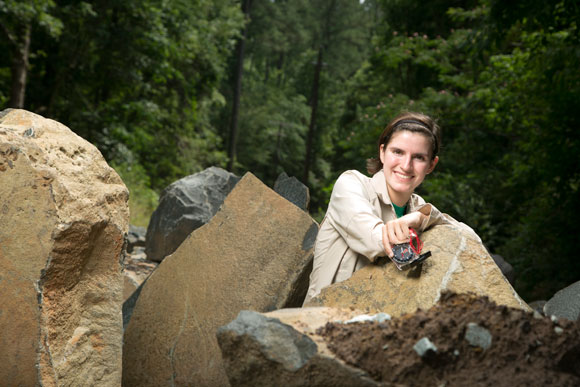
Duke senior Virginia “Ginny” Isava vividly remembers the day she fell in love with rocks.
A freshman at the time, she was sitting in an intro class on earth and ocean sciences, examining field samples –sedimentary, metamorphic, igneous – when the first twinge of infatuation hit.
“Learning about these ancient things that had been around forever, and figuring out how they came to be and what’s happened to them, was so interesting to me,” she recalls. “The next semester I took courses in geology and volcanology. Then, we took a class trip to Hawaii to study the volcanos and see the different types of lava in their natural environment, and I was hooked.”
Isava decided to major in earth and ocean sciences with a focus on geology.
“My favorite part is the fieldwork,” she says. “I enjoy learning things in class, but when you actually see the rock in its environment and hold it in your hands – that’s when you learn the most.”
Isava took advantage of a Stanback Internship offered through Duke’s Nicholas School of the Environment to spend a summer doing research at Great Smoky Mountains National Park. She interned with Discover Life in America, a nonprofit organization that works with the National Park Service to catalogue species in the Smokies. While there, she applied for a research permit that enabled her to collect rock samples and spent her free time exploring, collecting and writing a field guide to the park’s geologic formations.
“Most petrology papers for the park were written in the 1960s, but not much has been done since,” she says. “I decided I wanted to add to what was already known about the differences between the formations in the park.
Isava became especially interested in garnet, a mineral that has “zones” – like the rings of a tree – which show the type of environment it was growing in during a particular time period. By analyzing the rock’s different zones, she explains, you can see how its environment changed over time.
During her junior year Isava worked with Nicholas School professor Alan Boudreau, to examine thin sections of the garnet samples. Boudreau taught her how to analyze the garnets using high-tech equipment such as a petrographic microscope and a microprobe, which shoots electrons into the rock sample to determine its chemical composition.
“Ginny is one of a number of undergraduate students I have had working on real-world geologic problems, projects that often have resulted in published papers in respectable journals,” Boudreau notes. “In Ginny’s case, her work is trying to understand over how long a time period the metamorphic overprint in the Great Smokies’ sediments took place.”
Now in her senior year, she continues to analyze garnet samples and is writing a research thesis about the changing environments in the Great Smoky Mountains.
Halfway through her Duke career, Isava was selected as a Mellon Mays Undergraduate Fellow, a national program that aims to increase diversity in higher education by encouraging underrepresented minorities to pursue careers in academia. The competitive fellowship program – up to five undergraduate students are selected from Duke University each year – funds Isava’s research and provides learning opportunities to prepare her for a PhD program in structural geology. She has submitted a paper on her research that she hopes will be chosen for the 2015 Mellon Mays Undergraduate Fellowship Journal.
“The Mellon Mays Fellowship made me realize that I was capable of pursuing an academic in a field I am passionate about,” she says. “Now my ultimate goal is to be a professor so I can do the two things I love: research and teaching.”